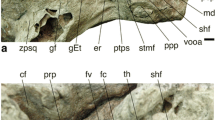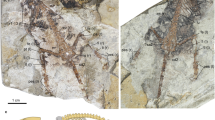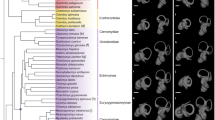Abstract
The extinct clade of caviomorph rodents Neoepiblemidae includes forms that lived in South America from the early Miocene to Pliocene. Among them is Perimys. The exceptional preservation of ear ossicles in this rodent is described and analyzed in a study of the phylogenetic transformations of these structures in caviomorphs including 21 extant and two extinct genera. Caviomorphs exhibit a conserved malleoincudal complex, with synostosis of the malleus and incus, “bullet-shaped” mallear head, and absence of orbicular apophysis. They also show a reduction of the mallear anterior process, in some cases even lacking this structure. The malleoincudal complex of Perimys shows an elongation of the head, but not as marked as in Chinchillinae. The incudal long process of Perimys is slightly more prolonged than the short process, as in chinchillids. In contrast, dinomyids have the incudal long process disproportionally more prolonged than in most caviomorphs. Concerning the disparity of caviomorph middle ear ossicles, Perimys shares the morphospace with chinchillids and other small forms. Within chinchilloids, Perimys is closer to chinchillids than to neoepiblemids.










Similar content being viewed by others
References
Albuquerque AGS, Rossato M, Oliveira JAA, Hyppolito MG (2009) Understanding the anatomy of ears from guinea pigs and rats and its use in basic otologic research. Braz J Otorhinolaryngol 75(1):43–49. https://doi.org/10.1016/S1808-8694(15)30830-2
Argyle EC, Mason MJ (2008) Middle ear structures of Octodon degus (Rodentia: Octodontidae), in comparison with those of subterranean caviomorphs. J Mammal 89:1447–1455. https://doi.org/10.1644/07-MAMM-A-401.1
Bondesio P, Pascual R, Vucetich MG (1975) Los Neoepiblemidae (Rodentia, Caviomorpha): su caracterización y sus relaciones filogenéticas con los Chinchillidae. Actas del Primer Congreso Argentino de Paleontología y Bioestratigrafía, Tomo 2:431–447
Bouxin G (2005) Ginkgo, a multivariate analysis package. J Veg Sci 16:355–359
Bryant JD, McKenna MC (1995) Cranial anatomy and phylogenetic position of Tsaganomys altaicus (Mammalia: Rodentia) from the Hsanda Gol Formation (Oligocene), Mongolia. Am Mus Novitates 3156:1–42
Cahn AR (1930) Auditory ossicles of living and giant beavers. J Mammal 11(3):292–299
Cisneros JC, Ruta M (2010) Morphological diversity and biogeography of procolophonids (Amniota: Parareptilia). J Syst Palaeontolol 8(4): 607–625. https://doi.org/10.1080/14772019.2010.491986
Cockerell TDA, Miller LI, Printz M (1914) The auditory ossicles of American rodents. Bull Am Mus Nat Hist, 33:347–380
Costeur L, Mennecart B, Muller B, Schulz G (2016) Middle ear bones of a mid-gestation ruminant foetus extracted from X-ray computed tomography. In: Stock SR, Müller B, Wang G (eds) Developments in X-Ray Tomography X. Proceedings of SPIE - The International Society for Optical Engineering 9967:1–8. https://doi.org/10.1117/12.2238119
Doran AHG (1878) Morphology of the mammalian ossicula auditus. Trans Linn Soc Lond 1:371–497
Fabre P-H, Hautier L, Dimitrov D, Douzery EJP (2012) A glimpse on the pattern of rodent diversification: a phylogenetic approach. BMC Evol Biol 12(88): 1–19. https://doi.org/10.1186/1471-2148-12-88
Fields RW (1957) Hystricomorph rodents from the late Miocene of Colombia, South America. Univ Calif Publ Geo Sci 32:273–404
Fleischer G (1973) Studien am Skelett des Gehörorgans der Säugetiere, einschließlich des Menschen. Säugetierkundliche Mitteilungen 21:131–239
Fleischer G (1978) Evolutionary principles of the mammalian middle ear. Adv Anat Embryol Cell Biol 55:1–70
Gaetano LC, Abdala F (2015) The stapes of gomphodont cynodonts: insights into the middle ear structure of non-mammaliaform cynodonts. PLoS One 10(7): e0131174. https://doi.org/10.1371/journal.pone.0131174
Goloboff P, Catalano S (2016) TNT version 1.5, including a full implementation of phylogenetic morphometrics. Cladistics 32(3):221–238. https://doi.org/10.1111/cla.12160
Hammer Ø, Harper DAT, Ryan PD (2001) PAST: paleontological statistics software package for education and data analysis. Palaeontol Electron 4(1):1–9
Horovitz I, Sánchez-Villagra MR, Martin T, Aguilera AO (2006) The fossil record of Phoberomys pattersoni Mones 1980 (Mammalia, Rodentia) from Urumaco (late Miocene, Venezuela), with an analysis of its phylogenetic relationships. J Syst Palaeontol 4:293–306. https://doi.org/10.1017/S1477201906001908
Huchon D, Catzeflis FM, Douzery EJP (2000) Variance of molecular datings, evolution of rodents, and the phylogenetic affinities between Ctenodactylidae and Hystricognathi. Proc R Soc Lond B Biol Sci 267: 393–402. https://doi.org/10.1098/rspb.2000.1014
Huchon D, Madsen O, Sibbald MJJB, Ament K, Stanhope MJ, Catzeflis F, De Jong WW, Douzery EJP (2002) Rodent phylogeny and a timescale for the evolution of Glires: evidence from an extensive taxon sampling using three nuclear genes. Mol Biol Evol 19: 1053–1065
Kemp TS (2007) Acoustic transformer function of the postdentary bones and quadrate of a non-mammalian cynodont. J Vertebr Paleontol 27:431–441
Kerber L, Negri FR, Ribeiro AM, Nasif N, Pereira Souza-Filho J, Ferigolo J (2017) Tropical fossil caviomorph rodents from the southwestern Brazilian Amazonia in the context of the South American faunas: systematics, biochronology, and paleobiogeography. J Mammal Evol 24:57–70. https://doi.org/10.1007/s10914-016-9340-2
Koyabu D, Hosojima M, Endo H (2017) Into the dark: patterns of middle ear adaptations in subterranean eulipotyphlan mammals. R Soc open sci 4: 170608. https://doi.org/10.1098/rsos.170608
Kraglievich L (1940) Los roedores de la familia extinguida Neoepiblemidae. In: Torcelli AJ, Morelli CA (eds) Obras de Geología y Paleontología 3 (Obras completas y trabajos científicos inéditos). Ministerio de Obras Públicas de la Província de Buenos Aires, Buenos Aires, pp 741–764
Kramarz AG, Vucetich MG, Arnal M (2013) A new early Miocene chinchilloid hystricognath rodent; an approach to the understanding of the early chinchillid dental evolution. J Mammal Evol 20:249–261. https://doi.org/10.1007/s10914-012-9215-0
Luo Z-X (2011) Developmental patterns in Mesozoic evolution of mammal ears. Annu Rev Ecol Evol Syst 42:355–380
Luo Z-X, Schultz JA, Ekdale EG (2016) Evolution of the middle and inner ears of mammaliaforms: the approach to mammals. In: Clack JA, Fay, RR, Popper AN (eds) Evolution of the Vertebrate Ear—Evidence from the Fossil Record. Springer Handbook of Auditory Research 59:139–174. https://doi.org/10.1007/978-3-319-46661-3_6
Maddison WP, Maddison DR (2015) Mesquite: a modular system for evolutionary analysis. Version 3.03. Available in: http://mesquiteproject.org/. Accessed 11 April 2016.
Maier W, Ruf I (2016) The anterior process of the malleus in Cetartiodactyla. J Anat 228:313–323. https://doi.org/10.1111/joa.12393
Maier W, Van Den Heever J (2002) Middle ear structures in the Permian Glanosuchus sp. (Therocephalia, Therapsida), based on thin sections. Mitteil Mus Naturkd Berl Geowiss 5:309–318
Martins LL, Almeida-Silva I, Rossato M, Murashima AAB, Hyppolito MA, Machado MRF (2015) Macroscopic description of the external and middle ear of paca (Cuniculus paca Linnaeus, 1766). Pesqui Vet Bras 35(6):583–589. https://doi.org/10.1590/S0100-736X2015000600017
Mason MJ (2004) The middle ear apparatus of the tuco-tuco Ctenomys sociabilis (Rodentia, Ctenomyidae). J Mammal 85:797–805. https://doi.org/10.1644/BEL-102
Mason MJ (2013) Of mice, moles and guinea-pigs: functional morphology of the middle ear in living mammals. Hear Res 301:4–18. https://doi.org/10.1016/j.heares.2012.10.004
Mason MJ (2015) Functional morphology of rodent middle ears. In: Cox PG, Hautier L (eds) Evolution of the Rodents: Advances in Phylogeny, Functional Morphology and Development. Cambridge University Press, Cambridge, pp 373–404.
Meng J (1992) The stapes of Lamdopsalis bulla (Multituberculata) and transformational analyses on some stapedial features in Mammaliaformes. J Vertebr Paleontol 12(4):459–171
Meng J, Bi S, Zheng X, Wang X (2016) Ear ossicle morphology of the Jurassic euharamiyidan Arboroharamiya and evolution of mammalian middle ear. J Morphol. https://doi.org/10.1002/jmor.20565
Meng J, Wang YQ, Li CK (2011) Transitional mammalian middle ear from a new Cretaceous Jehol eutriconodont. Nature 472:181–185. https://doi.org/10.1038/nature09921
Mones A (1974) Estudios sobre la familia Hydrochoeridae (Rodentia), III. Osteología comparada de la región auditiva de Hydrochoerus Brisson con formas afines. Ameghiniana 11(1):39–57
Mones A (1997) Estudios sobre la familia Dinomyidae, II. Aportes para una osteologia comparada de Dinomys branickii Peters, 1873 (Mammalia: Rodentia). Comunicaciones Paleontológicas del Museo Nacional de Historia Natural de Montevideo 29:1–40
Moore WJ (1981) The Mammalian Skull. Cambridge University Press, Cambridge
Nasif N (2009) Los Dinomyidae (Rodentia, Caviomorpha) del Mioceno superior del noroeste argentino. Su anatomía cráneo-dentaria. Ph.D. Thesis, Facultad de Ciencias Naturales and Instituto Miguel Lillo Universidad Nacional de Tucumán, Tucumán, 363 pp
Novacek MJ (1993) Patterns of diversity in the mammalian skull. In: Hanken J, Hall BK (eds) The Skull. 2. Patterns of Structural and Systematic Diversity. University of Chicago Press, Chicago, pp 438–545
Novacek MJ, Wyss A (1986) Origin and transformation of the mammalian stapes. Contrib Geol Univ Wyoming Spec Pap 3:35–53
Orliac MJ, Billet G (2016) Fallen in a dead ear: intralabyrinthine preservation of stapes in fossil artiodactyls. Palaeovertebrata 40(1)-e3:1–10. https://doi.org/10.1080/08912963.2017.1294168
Rasia LL, Candela AM (2017) Reappraisal of the giant caviomorph rodent Phoberomys burmeisteri (Ameghino, 1886) from the late Miocene of northeastern Argentina, and the phylogeny and diversity of Neoepiblemidae. Historical Biol. https://doi.org/10.1080/08912963.2017.1294168
Rich TH, Hopson JA, Musser AM, Flannery TF, Vickers P (2005). Independent origins of middle ear bones in monotremes and therians. Science 307:910–914. https://doi.org/10.1126/science.1105717
Rodrigues PG, Ruf I, Schultz CL (2013) Digital reconstruction of the otic region and inner ear of the non-mammalian cynodont Brasilitherium riograndensis (Late Triassic, Brazil) and its relevance to the evolution of the mammalian ear. J Mammal Evol 20:291–307. https://doi.org/10.1007/s10914-012-9221-2
Rohlf FJ (2017) TPSDig software series, digitize landmarks & outlines from image files, scanner, or video, version 2.29. Stony Brook, Department of Ecology and Evolution, State University of New York. http://life.bio.sunysb.edu/morph/index.html. Accessed 30 January 2016
Sánchez-Villagra MR, Aguilera O, Horovitz I (2003) The anatomy of the world’s largest extinct rodent. Science 301:1708–1710. https://doi.org/10.1126/science.1089332
Sánchez-Villagra MR, Gemballa S, Nummela S, Smith KK, Maier W (2002) Ontogenetic and phylogenetic transformations of the ear ossicles in marsupial mammals. J Morphol 251:219–238. https://doi.org/10.1002/jmor.1085
Sánchez-Villagra MR, Nummela S (2001) Bullate stapes in some phalangeriform marsupials. Mammal Biol 66:174–177
Schleich CE, Busch C (2004) Functional morphology of the middle ear of Ctenomys talarum (Rodentia: Octodontidae). J Mammal 85:290–295
Schmelzle T, Nummela S, Sánchez-Villagra MR (2007) Phylogenetic transformations of the ear ossicles in marsupial mammals, with special reference to diprotodontians: a character analysis. Ann Carnegie Mus 74(3):189–200
Sidorkewicj NS, Casanave EB (2012) Morphology of the middle ear in three species of armadillos (Dasypodidae, Xenarthra) from Argentina. Internatl J Morphol 30(4):1500–1507. https://doi.org/10.4067/S0717-95022012000400038
Stoessel A, Gunz P, David R, Spoor F (2016) Comparative anatomy of the middle ear ossicles of extant hominids: introducing a geometric morphometric protocol. J Hum Evol 91:1–25. https://doi.org/10.1016/j.jhevol.2015.10.013
Upham NS, Patterson BD (2015) Evolution of the caviomorph rodents: a complete phylogeny and time tree of living genera. In: Vassallo A, Antonucci D (ed) Biology of Caviomorph Rodents: Diversity and Evolution. Sociedad Argentina para el estudio de los Mamíferos, Buenos Aires, pp 63–120
Voloch CM, Vilela JF, Loss-Oliveira L, Schrago CG (2013) Phylogeny and chronology of the major lineages of New World hystricognath rodents: insights on the biogeography of the Eocene/Oligocene arrival of mammals in South America. BMC Res Notes 6(160):1–9. https://doi.org/10.1186/1756-0500-6-160
Voss RS (2011) Revisionary notes on Neotropical porcupines (Rodentia: Erethizontidae). 3. An annotated checklist of species of Coendou Lacépède, 1799. Am Mus Novitates 3720:1–36
Vrettakos PA, Steve T, Dear SP, Saunders JC (1988) Middle ear structure in the chinchilla: a quantitative study. Am J Otolaryngol 9:58–67
Vucetich MG (1975) La anatomia del oido medio como indicadora de rleaciones sistematicas y filogeneticas en algunos grupos de roedores Caviomorpha. Actas del Primer Congreso Argentino de Paleontología y Bioestratigrafía 2:447–494
Vucetich MG, Arnal M, Deschamps CM, Pérez ME, Vieytes EC (2015) A brief history of caviomorph rodents as told by the fossil record. In: Vassallo A, Antonucci D (eds) Biology of Caviomorph Rodents: Diversity and Evolution. Sociedad Argentina para el estudio de los Mamíferos, Buenos Aires, pp 11–62
Vucetich MG, Vieytes EC, Perez ME, Carlini AA (2010) The rodents from La Cantera and the early evolution of caviomorphs in South America. In: Madden RH, Carlini AA, Vucetich MG, Kay RF (eds) The Paleontology of Gran Barranca, Evolution and Environmental Change through the Middle Cenozoic of Patagonia. Cambridge University Press, Cambridge, pp 189–201
Wible JR, Spaulding M (2012) A reexamination of the Carnivora malleus (Mammalia, Placentalia). PLoS One 7(11):e50485. https://doi.org/10.1371/journal.pone.0050485
Wilkins KT, Roberts JC, Roorda CS, Hawkins JE (1999) Morphometrics and functional morphology of middle ears of extant pocket gophers (Rodentia, Geomyidae). J Mammal 80:180–198. https://doi.org/10.2307/1383218
Wills MA (1998) Cambrian and recent disparity: the picture from priapulids. Paleobiology 24:177–199
Wills MA, Briggs DEG, Fortey RA (1994) Disparity as an evolutionary index: a comparison of Cambrian and Recent arthropods. Paleobiology 20:93–130. https://doi.org/10.1017/S009483730001263X
Acknowledgements
We would like to express our gratitude to: CNPq (Conselho Nacional de Pesquisa e Tecnologia) [Process CNPq 8, 201356/ 2015-5 (L.K)]. Elio Massoia organized the collection of most of the specimens analyzed herein; they were extracted from the middle ear of these rodents by him and other researches. Maria Guiomar Vucetich kindly gave us most of the specimens – another example of her extraordinary mentorship to younger (and not so young) rodent researchers. Universität Zürich provided the infrastructure for this work. Rodrigo Temp Müller helped us with the disparity morphospace occupation analysis, Felipe Pinheiro, read and commented the first draft of this manuscript, and Juan D. Carrillo kindly revised an advanced version and provided useful comments. We thank Diego Verzi for his assistance as curator of the mastozoology section at the MLP and Martina Schenkel curator at the Zoologisches Museum, University of Zurich; two reviewers and the editor-in-chief John Wible for their useful comments. TNT v.1.5 was used for phylogenetic analysis. This is a program made freely available thanks to a subsidy by the Willi Hennig Society.
Author information
Authors and Affiliations
Corresponding author
Rights and permissions
About this article
Cite this article
Kerber, L., Sánchez-Villagra, M.R. Morphology of the Middle Ear Ossicles in the Rodent Perimys(Neoepiblemidae) and a Comprehensive Anatomical and Morphometric Study of the Phylogenetic Transformations of these Structures in Caviomorphs. J Mammal Evol 26, 407–422 (2019). https://doi.org/10.1007/s10914-017-9422-9
Published:
Issue Date:
DOI: https://doi.org/10.1007/s10914-017-9422-9




